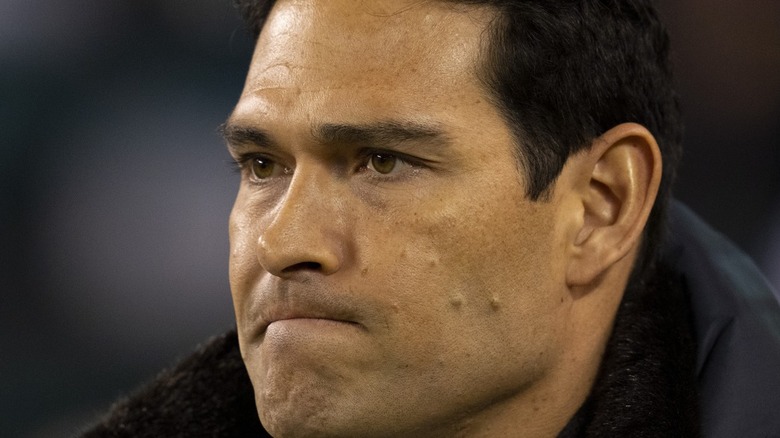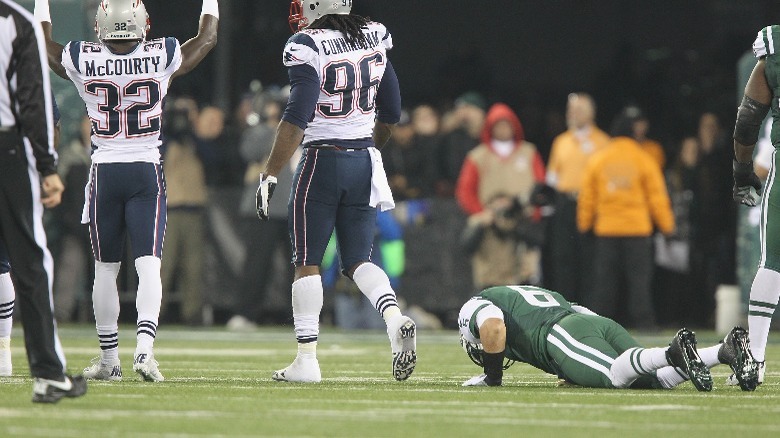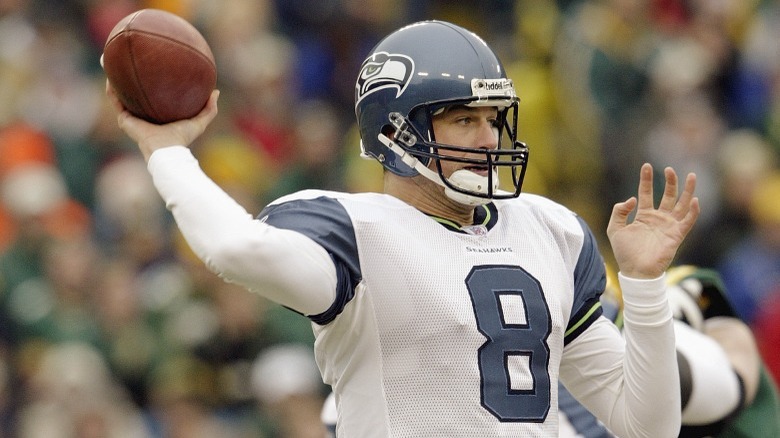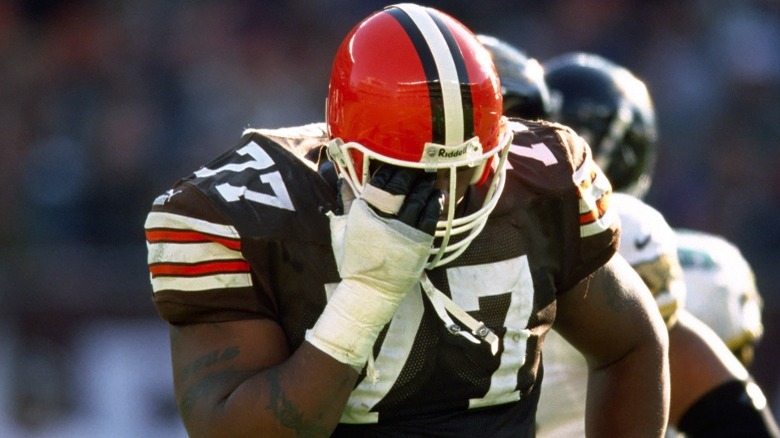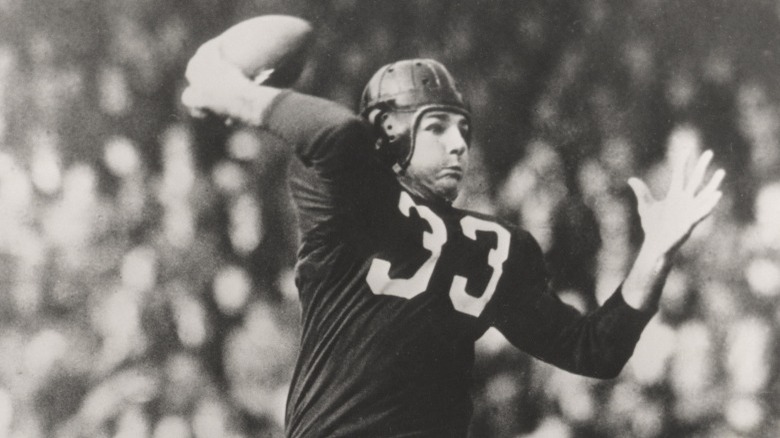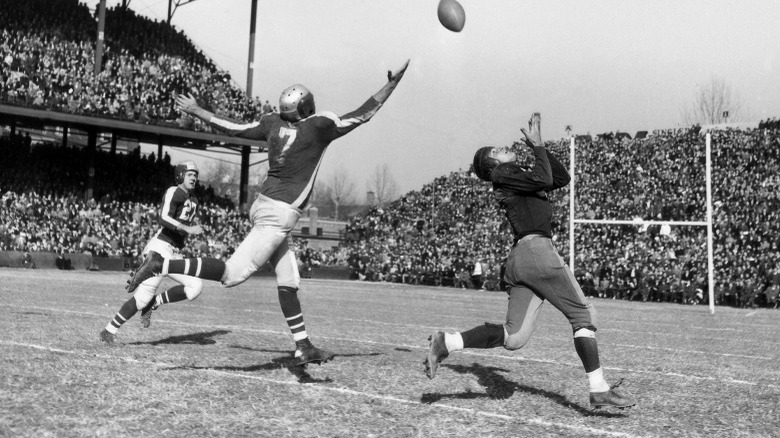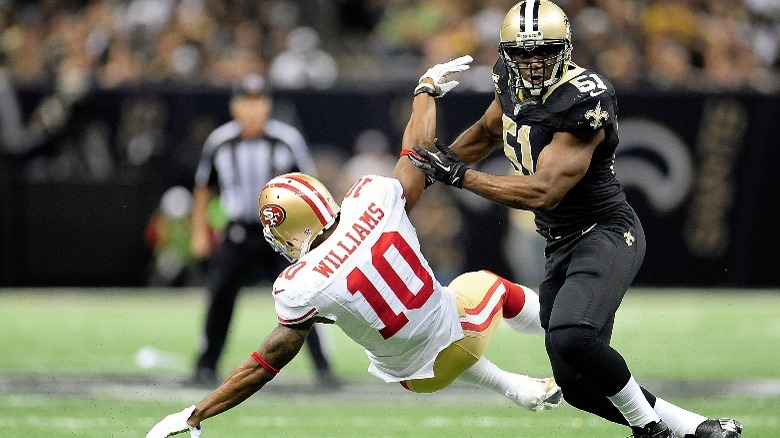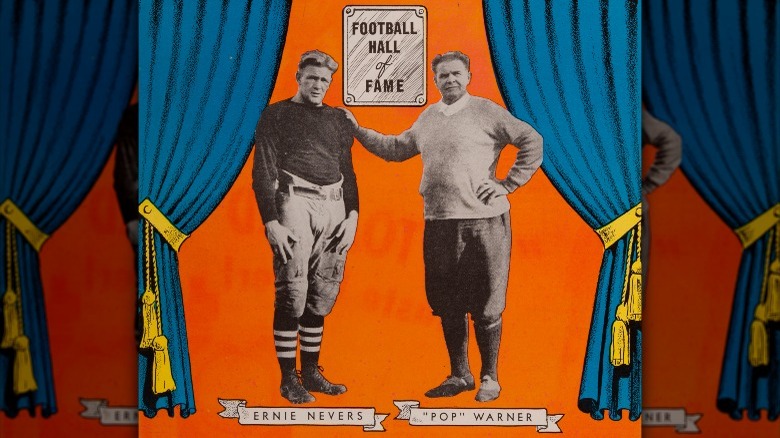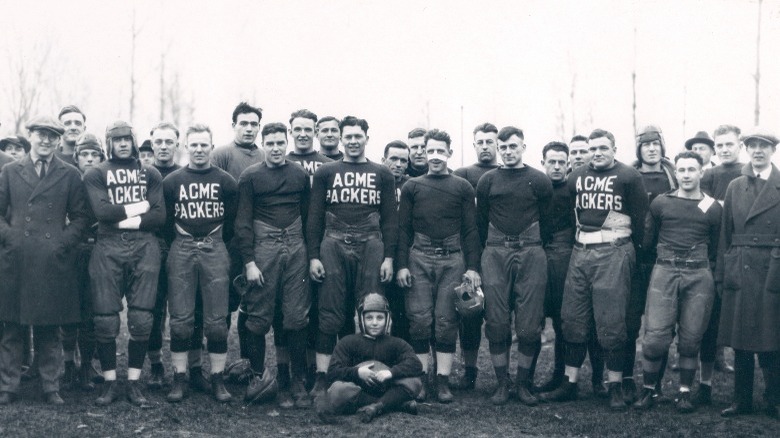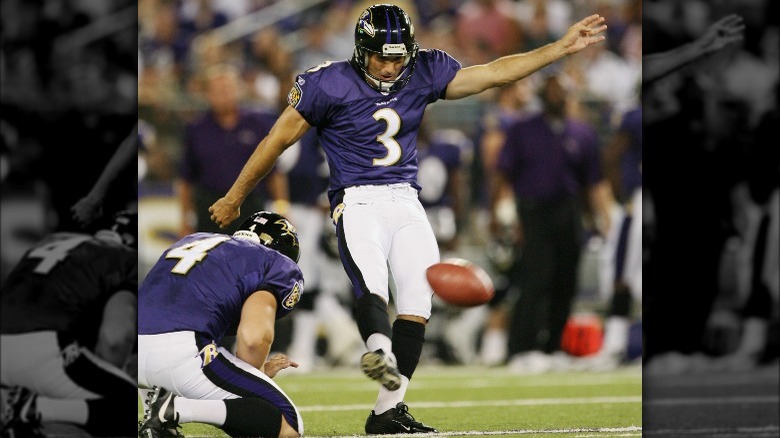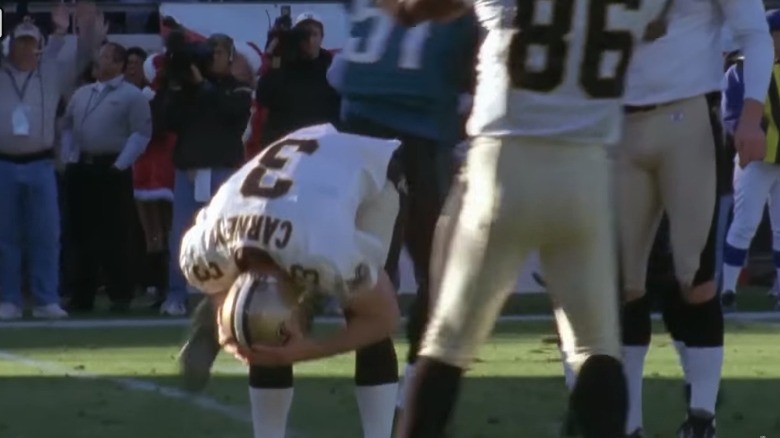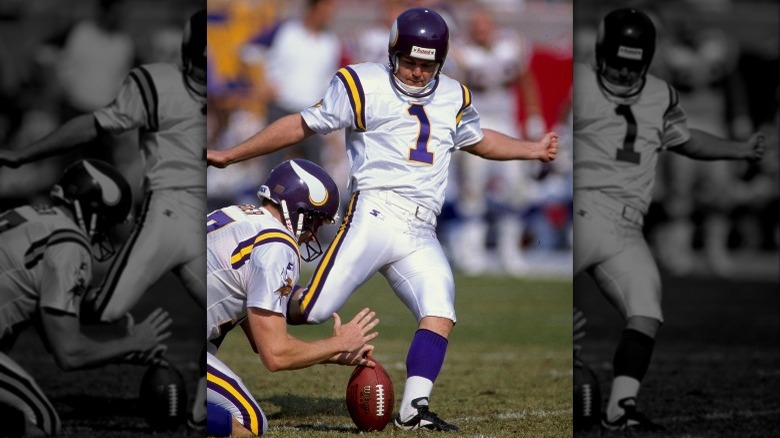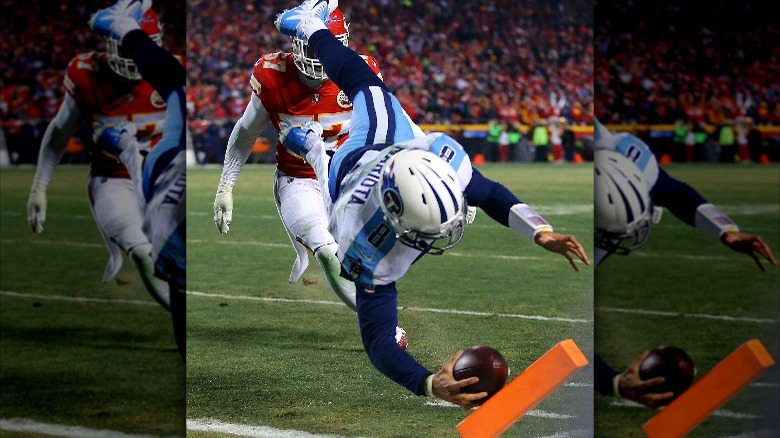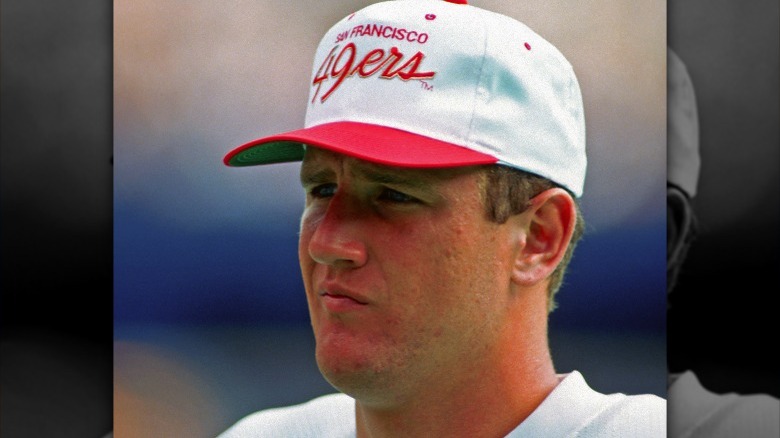Football Stories That Sound Fake But Aren't
Over the years, the NFL has certainly had its fair share of wild and crazy moments. Eccentric and larger-than-life superstars have changed the game in countless ways, and things that were once thought to be impossible — like throwing for more than 5,000 yards and more than 40 touchdowns — are now becoming regular benchmarks throughout the league. Every year the players get bigger, stronger, and faster, and the games just keep getting more and more exciting from a physical standpoint.
Yet, the game has not lost any of its spontaneity or free spirit, and it still seems like almost every week something happens that has never been seen before. From quarterback Mark Sanchez getting plowed over by his own offensive lineman's rear-end, to Matt Hasselbeck's ill-fated quip during the 2003 NFC Championship game, you can still find something unique and extraordinary every time you watch a football game.
Sometimes, the feats are almost too outlandish or outrageous to be believed, but truth can be stranger than fiction. Here are the top 14 football stories that sound fake, but aren't.
The Mark Sanchez butt-fumble
For as outrageous as it sounds now, at one point former New York Jet Mark Sanchez was considered to be one of the more promising young quarterbacks in the league. During his first two seasons, he piloted the Jets to the AFC Championship game in consecutive seasons. Though they lost both times, the former first-round pick Sanchez seemed to improve every year, throwing for more touchdowns and more yardage.
Then the 2012 season happened, and everything fell off the rails for Sanchez and the Jets. Yet, in the midst of the darkness, one of the greatest NFL memes of all time was born: The butt fumble. The Jets were down 14-0 on Thanksgiving 2012 , when Sanchez called a running play to his fullback, at least he thought he did. There was a miscommunication, and when Sanchez dropped back to hand off the ball, his fullback wasn't there. Instead of giving up, Sanchez tried to make something of nothing, but things only got worse. He tried to scramble but, instead of daylight, found Jets lineman Brandon Moore's rear-end, and he proceeded to run directly into it.
This caused him to fumble, which was quickly returned for a defensive touchdown. While fumbling isn't exactly rare, it almost defies logic that an offensive lineman would be the cause of it. It's one of the great gaffes in NFL history, and really has to be seen to be believed.
Matt Hasselbeck really wanted the ball
When the Seattle Seahawks took on the Green Bay Packers in the 2003 NFC Wild Card game, you knew from the get-go that sparks were going to fly. And after four chilly quarters of exciting football at the legendary Lambeau Field in Wisconsin, the teams were tied at 27 apiece.
When it came time for the coin toss to determine who would start with the ball for overtime, the Seahawks ended up winning the toss. When asked if they wanted to receive the ball or kick, Seahawks quarterback Matt Hasselbeck told the head referee, "We want the ball, we're gonna score!" He likely did not realize that what he said was being caught on a hot mic, but everyone in the stadium and at home heard what he had said.
And while making a prediction and being wrong isn't too unbelievable, the circumstances of the Packers' victory are. After making a boast like that, you have to deliver, and Hasselbeck did — but for the Packers. Less than five minutes after making his prediction, he threw a game-ending pick-six to Packers defensive back Al Harris. As far as regrettable smack-talk, this one has to take the cake, and is likely one that Hasselbeck would like to take back.
Flag on the... referee?
One of the least fortunate parts about football is the litany of injuries that happen every season. From torn ACLs and MCLs, to devastating concussions and head/spinal injuries, just about every year at least a few star players are brought down by the injury bug. While there have been some occasional freak accidents, nothing quite stands out like the incident with offensive tackle Orlando "Zeus" Brown on December 19, 1999.
That season, Brown was playing for the Cleveland Browns as their starting tackle, and was widely considered one of the best players in the league. However, during the game, referee Jeff Triplette carelessly threw a penalty flag during a play. It wound up hitting Brown in his right eye, temporarily blinding him and causing him a ton of pain (via The New York Times). An outraged Brown pushed Triplette in anger, leading to a suspension. But that was far from the worst of it for Brown.
He was immediately sent to the hospital to get his eye checked out, and he was out of football for years, missing three full seasons from 2000–2002. However, he did wind up getting a roughly $20 million settlement from the league in 2002. In 2003, he revived his career with the Baltimore Ravens, who were coincidentally the same team Cleveland was playing when Brown injured his eye. Brown died in 2011 at the age of 40.
Sammy Baugh does it all
Since the days of Deion Sanders, the NFL has not seen a regular two-way player who could excel on both offense and defense. Yet, Sanders was far from the first player to have done so, and in the earlier days of the league ,it was actually pretty commonplace. One of the finest to ever do it was "Slinging" Sammy Baugh. Baugh had a 16-year NFL career from 1937–1952 as one of the most prolific quarterbacks in the league, and starting in 1940, he also began to play as a defensive back.
Now a hall of famer, Baugh had one of the all-time greatest games in NFL history on November 14, 1943. As a member of Washington's football team, they were taking on the Detroit Lions, who were led by rookie quarterback and number one overall pick in the 1943 draft Frankie Sinkwich. However, Sinkwich and the Lions were no match for Baugh, who almost single-handedly took them down.
On offense, Baugh threw for four touchdowns and had an 81-yard punt return on special teams (via Sports Illustrated). He also had four interceptions against Sinkwich as a defensive back, which contributed to an NFL record 11 that season. Incredibly, Sinkwich also had an interception himself as a defensive back, which he returned for a touchdown, in addition to his two passing touchdowns. It sure was a different era back then.
The 1943 Philadelphia Steagles
While they do not meet particularly often due to playing in different conferences, the Philadelphia Eagles and Pittsburgh Steelers have one of the oldest rivalries in NFL history. Both teams hail from the state of Pennsylvania, and both trace their inaugural year back to 1933. However, just 10 years later, both teams were forced to put aside their rivalries for the 1943 season.
Due to WWII, both teams were short of the necessary players to field a full team, so the only option was for them to join together (via the Eagles). They became known as the Steagles, a portmanteau of Steelers and Eagles. They played their home games at the former Shibe Park, and Greasy Neale and Walt Kiesling — the coaches of the Steelers and Eagles the previous seasons — co-coached the team together.
The team did not fare particularly well, going 5-4-1 and placing third in their division, missing the playoffs. The Eagles and Steelers would return to full strength the following seasons, and the Steagles were dead. Looking back, it was one of the more inconceivable ways to pull off a season, but it worked for the Steagles and saved football for Pennsylvania in 1943.
The BountyGate scandal
Even though the NFL has started to emphasize safety and health far more in recent years, football is still widely regarded as an incredibly violent and, at times, dangerous game. When you have some of the best athletes in the world running full speed at each other with the intention of making hard and swift contact, there are bound to be some injuries and misfortunes. Yet, while some of the best defensive players in history have made their name through bone-crushing hits, most people chalk that up to playing hard, rather than intentionally injuring the other players.
That's what made the New Orleans Saints' Bountygate scandal so incredibly crazy and unimaginable when details about it first emerged. In early 2012, the NFL began investigating the Saints for an alleged bounty program, where players were supposedly given cash incentives for physically injuring star players on other teams (via ESPN). Several players and coaches ended up with suspensions, which kicked off an ugly legal battle that embarrassed the league severely.
Eventually, all suspensions were overturned, except the coaches, but not before some egregiously damaging information came out about the Saints players and coaches related to the disgusting bounty program. Even today, over a decade later, it's still hard to believe how horrifying the program was, but at least it's over now.
Ernie Nevers' unbelievable game
Today, the fullback is a lost art in the NFL. Many teams don't even carry one on their roster, and those that do only use them sparingly. Nowadays, the NFL is largely a passing league, with rushing totals at times becoming obsolete. It's a far cry from the football games played for the majority of the 1900s, when running backs and fullbacks were some of the most important members of the entire team.
That's part of what makes fullback Ernie Nevers' feat on November 28, 1929, one of the most incredible in all of NFL history. That day, George Halas' Chicago Bears were taking on Dewey Scanlon's Chicago Cardinals at the famous Comiskey Park, with about 8,000 screaming fans in attendance. Nevers was a member of the Cardinals, and he put on quite the show. He scored all 40 of the Cardinals' points, which included six rushing touchdowns and four extra-point kicks, because in those days players often kicked their own extra points.
Nearly a century later, it still stands as the all-time record for most points in a single game. It's likely we'll never see something that incredible again, and it stands as one of the most amazing feats in sports history. Nevers would play for another two seasons in the league following 1929, and would end up elected to the Pro Football Hall of Fame in 1963.
The Packers brief exodus
The 1921 season was a strange one for the NFL. At the time, it was still known as the American Professional Football Association (APFA), and the league had quite the collection of teams. Most of them hailed from either Illinois or Ohio, and four of the teams folded after playing two or fewer games, including the Tonawanda Kardex and the New York Brickley Giants. It was also the Green Bay Packers' first season in the league, where they finished with a 3-2-1 record. Incredibly, it was almost the last Green Bay Packers' season in the league, too.
After the season, the Packers had been caught using college players on their team for some games, and in January 1922, were actually forced out of the league as a result (according to the Packers). The exact details of the scandal are disputed and debated, but they end with the Packers being kicked out of the APFA for almost six months. They were allowed back that June, and have been with the league for more than a century since. Still, it's hard to believe one of the oldest teams almost didn't make it past their first season.
Matt Stover scores 49 consecutive points for Baltimore
The 2000 Baltimore Ravens were a bit of an enigma. They had one of the most dominant defenses of the league that year, which was led by future hall of famers Ray Lewis and Rod Woodson. However, their offense was middle of the road at best, and they barely had more touchdowns than turnovers by the end of the regular season.
One of the most remarkable indications of just how inept the Ravens' offense could be happened halfway through the season, when their kicker — that's right, the kicker — scored 49 consecutive points for the team. He was the only Ravens offensive player to put a point on the scoreboard for an incredible five-game stretch, from weeks five to nine. Starting with the final extra point and field goal from week four, Stover would be the only Raven offensive player to score until Brandon Stokley caught a touchdown pass in week 10.
During that stretch, Stover kicked 16 consecutive field goals, and the Ravens won two out of three games. Amazingly, this was the Ravens' Super Bowl season, which again just shows how good their defense was. This is another streak that will probably never be broken again, and thus likely to be the greatest stretch of any kicker's NFL career.
John Carney ruins the River City Relay
On December 21, 2003, with 7 seconds to go in the fourth quarter and in the middle of the playoff race, the New Orleans Saints found themselves down 13–20 to the Jacksonville Jaguars. With the ball on their own 25-yard line, the Saints needed nothing short of a miracle to find a way and tie the game, and they almost found it.
Saints quarterback Aaron Brooks snapped the ball and heaved a pass to wide receiver Donté Stallworth, who evaded multiple defenders before lateraling it to teammate Michael Lewis. Lewis then pitched it back to Deuce McAllister, who made a desperation heave to Jerome Pathon in the middle of the field. Improbably, Pathon outran multiple Jaguars defenders and made it into the end zone, punctuating his touchdown with a dive and putting the Saints within one point of the Jaguars with time expired. It might just be the single greatest play in Saints history.
All they needed was kicker John Carney to make the chip-in extra point from 19 yards out, and they would face the Jags in overtime, with all of the momentum on their side. Then the unthinkable happened: Carney shanked the field goal wide right. A stunned silence poured over the stadium, as coaches, players, fans, and even the announcers, sat in disbelief. It is an all-time great gaffe, and truly speaks for itself.
The Gary Anderson miss
At the start of the 1998-1999 NFL postseason, the Minnesota Vikings had good reason to be confident about their kicking situation. They had Gary Anderson, and he had been perfect during the regular season, making 35 of 35 field goals and 59 of 59 extra points. The Vikings had made it all the way to the NFC Championship in early 1999, where they faced the Atlanta Falcons.
After a hard-fought battle, the Vikings were up 27–20 with just over 2 minutes left on the clock. After a Randall Cunningham incompletion on 3rd and 7, out trotted Anderson to put the Vikings ahead by two scores and likely punch their ticket to the Super Bowl. Unfortunately, for the first time in more than a calendar year, Anderson missed the field goal. During the season, he was a perfect 14 of 14 from 40 yards or greater, but just couldn't manage an easier 38-yarder when the Vikings needed him most.
This left the door open for Chris Chandler and the Falcons to come back, and Chandler promptly led them down the field for a game-tying touchdown. In overtime, Anderson never got a chance to kick again, and opposing kicker Morten Andersen won the game for the Falcons. Even with the miss, Anderson would go on to kick for another six seasons, and he is still widely regarded as one of the best kickers in history.
QBs throwing touchdown passes to themselves
As the saying goes, "it takes two to tango," and normally when you're talking about passing touchdowns in the NFL, that's indeed the case. After all, you need one player to throw the ball and another player to catch the ball, at a minimum. Well, no one told that to either quarterbacks Brad Johnson or Marcus Mariota, who both accomplished the seemingly impossible feat of throwing a touchdown pass to themselves.
Johnson did it first during the 1997 season as a member of the Minnesota Vikings against the Carolina Panthers. His pass attempt was batted down at the line and landed right back in his hands. After evading a few defenders, Johnson found daylight and ran untouched into the end zone, erupting in a roar of jubilation. Twenty years later, during the 2017 postseason, Mariota did the same thing to the Kansas City Chiefs when he was still a Tennessee Titan.
Mariota's touchdown was a little different, and involved a dramatic dive over the pylon to clinch it. Already scrambling, Mariota attempted a desperation heave into the end zone, when a Chiefs defensive back — hall of famer Darrelle Revis — swatted it back down, and right into Mariota's arms. Without breaking stride, Mariota caught the deflection and outstretched his hand into the end zone, scoring one of the craziest touchdowns in history. The only thing crazier is that it happened twice, and sure, it can't happen again, right?
Elvis Grbac: The sexiest man alive
When you think of People magazine's annual award for the "sexiest man alive," your mind probably goes toward famous actors and movie stars. Maybe even a politician or two, but almost certainly not ex-San Francisco 49er and Kansas City Chiefs quarterback Elvis Grbac, who won it in 1998. Despite being blessed with an incredible first name and a fantastic throwing arm, few people would have thought Grbac qualified for the "sexiest man alive" award, including, as it turns out, the people at People magazine themselves.
According to The Athletic, the original choice for the award was supposed to be Rich Gannon, who was serving as Grbac's backup that season for the Chiefs. However, when the People photographer made it to Kansas City, he ended up taking photos of the wrong quarterback, getting shots of Grbac instead of Gannon.
The magazine's editors quickly realized the mistake, but were too embarrassed and polite to admit it and retake the pictures of Gannon. In the end, Grbac was still named the 1998 People's Sexiest Man of the Year, much to his chagrin.
